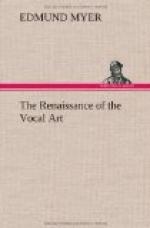It is true that with many, articulation is a difficult matter, and this is especially true on the high tones of the voice. No one who has heard the majority of the average opera and concert singers of the day, would be justified in holding that articulation is not a lost art. A free, distinct articulation and use of words in song, is the exception and not the rule. This is due largely to the following fact—with most singers there is direct or local effort on face, jaw, tongue and throat, during the act of singing; in other words, they grip the parts to hold the tone, and the higher or louder they sing, the firmer the grip or contraction. This virtually paralyzes action, and makes flexible articulation impossible. Articulation knows no pitch. It should be as easy on a high tone as on a middle or low tone. If there were no direct or local effort of the articulating muscles to hold the tone, articulation on the high tone would be as easy as on the middle or low tone. This is a fact which has been demonstrated again and again. Of course it is more difficult to learn to sustain the high tone without placing more or less effort upon the face, jaw, and throat; but under right conditions, the result of right position and action, this can be done, and has been done many times.
Articulation, to be artistic, must be spontaneous,—the thought before the action. Think and feel the effect desired, and give no thought to the action of articulation. The action, under right conditions, if there is no restraint, will respond to thought and feeling; it will be automatic and spontaneous. Just as the singer, after a certain stage of study, should never produce a tone that does not mean something, that has not character, so in the use of words, he should always sing them in a persuasive, impressive manner, and with free, flexible action. As, under this system, we never locally influence vowel form, so, after a certain stage of study we never locally influence consonantal action. To be right, it must be automatic and spontaneous.
Of course we recognize the fact that in all vocal study there must be a beginning. The pupil must be taught to know and think correct physical or mechanical action in singing. He must know what it is, what it means, and how to think it. Then it must be trained to respond to thought and will. This we call the first two stages of study, or the physical and mental. The mental, as the student progresses, must dominate and control the physical; and finally, as we have before stated, the true motor power is emotional energy or the singer’s sensation. This order of study and development holds good in this fifth principle of artistic singing, as in all others.
The device to which we first resort for the understanding and development of articulation, is a study of the three points or places of contact. On page 183 of “Vocal Reinforcement” (by the author of this work) will be found a full explanation of these three points.




